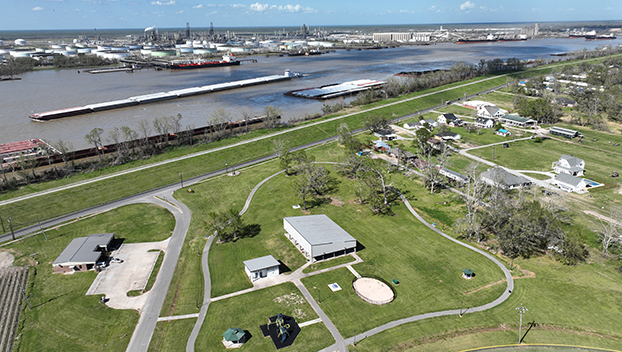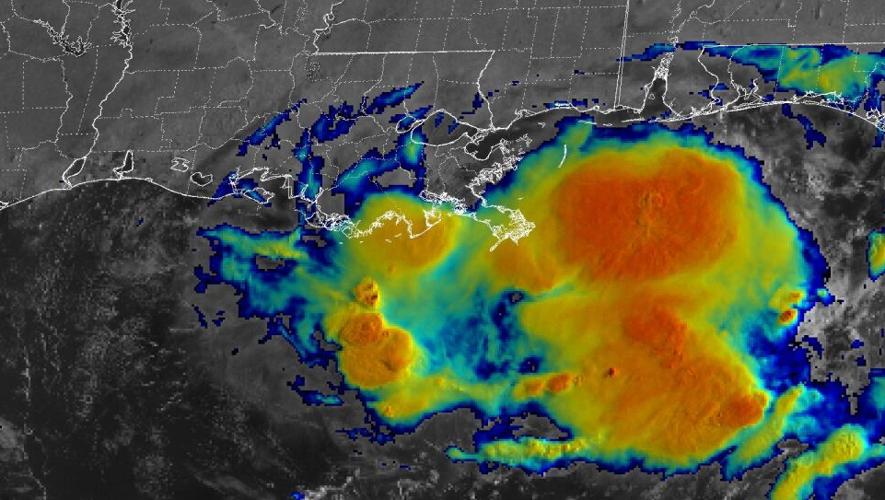West Bank added to list of ‘America’s 11 Most Endangered Historic Places’
Published 8:03 am Wednesday, May 17, 2023

- The West Bank of St. John Parish is seen from an aerial view with Garyville visible on the opposite side of the river. (Photo credit: Louisiana Trust for Historic Preservation)
|
Getting your Trinity Audio player ready...
|
WALLACE — The National Trust for Historic Preservation recently added the entire West Bank of St. John the Baptist Parish to its list of America’s 11 Most Endangered Historic Places in response to proposed industrial development.
The National Trust for Historic Preservation is a privately funded nonprofit founded more than 70 years ago to save American landmarks that connect to the past, anchor us to the present, and lead us into the future. The 11-mile stretch of land on the West Bank of St. John Parish is described as “the last untouched section of Louisiana’s German Coast.” According to a press release from Louisiana Trust for Historic Preservation, industrial development of this land poses a risk to more than three centuries’ worth of “agricultural tradition, historic sites, archaeological records, existing film and tourism industries, and a delicate natural ecosystem.”
The region was initially settled by Europeans in the 1720s as a farming community. The immigrant farmers contributed to the growth and survival of early New Orleans by taking their produce downriver to the market each week.
Trending
Wallace was founded in the aftermath of the Civil War as Black Union Army soldiers returned home to their families after fighting for their freedom. According to Louisiana Trust for Historic Preservation, this area remains heavily populated by the descendants of the enslaved who once worked on local plantations.
Today, Lucy, Edgard and Wallace are home to historic sites such as Whitney and Evergreen Plantations, museums that educate the public on the experiences of the enslaved. Other local sites listed on the National Register of Historic Places include the Sorapuru House, founded by free people of color in 1825 and owned by the same family since construction; the Haydel-Jones House (1815), the E.J. Caire Stores (1855 and 1897), the Bacas House (1840) and the Dugas House (1810). Early 19th Century architecture is considered historically significant because it exemplifies the Creole tradition that dominated the area before the introduction of Anglo-American influences.
Greenfield Louisiana LLC has proposed the development of a grain terminal in Wallace. The permit application is currently under review by the U.S. Army Corps of Engineers. Meanwhile, a group of community environmentalists known as the Descendants Project has sounded the alarm, in public and in court, about the potential impacts of industrial development to historically significant sites. Surveys have been conducted to investigate the possibility of unmarked burial sites of the enslaved in the area surrounding the planned development.
The Descendants Project has also spoken out against Greenfield Louisiana’s 30-year Payment in Lieu of Taxes (PILOT) agreement with the Port of South Louisiana, as well as the potential health impacts associated with industrial development in a corridor along the Mississippi River already known as “Cancer Alley.”
A press conference and media day was held Saturday, May 13 in Edgard. Descendants Project organizers announced that more than 2,000 signatures have been collected on a petition that urges the U.S. Army Corps of Engineers to deny Greenfield’s permit.
During the press conference, National Urban League President and former mayor of New Orleans Marc Morial said, “We don’t need another grain warehouse here in West St. John Parish which is really to serve an industry and consumers outside of the U.S. We are pro-jobs and pro-economic development, but there’s another vision.”
Trending
Exposing the West Bank of St. John Parish to heavy industry would result in a loss of people, existing industries and culture, according to Brian Davis, executive director of the Louisiana Trust for Historic Preservation.
“If a port and industrial sites are allowed to get a foothold in the West Bank of St. John the Baptist Parish, this distinctive culture, its historic record and what the people can teach us will be lost within the next 20 years,” Davis said. “When your family has existed for generations in a rural setting, you don’t want your kids to live entrenched in the noise, pollution and bright lights of an industrial zone.”
Katherine Malone-France, chief preservation officer for the National Trust for Historic Preservation, said the West Bank of St. John Parish is a “remarkable and profoundly important cultural landscape” with structures and archeological sites vital to teaching United States history.
“The potential construction of Greenfield Terminal threatens to dramatically harm this place and the multi-faceted community and culture that are inextricably tied to it,” she said. “We stand with local and national advocates, including the descendants of people enslaved in the area, to draw national attention to this place, its centrality to the identity and culture of those who call it home, and the potential it represents for all Americans to come together to protect our shared history.”
Organizers of the Greenfield project believe a state-of-the-art grain export facility can and must co-exist with historic preservation and responsible economic revitalization to benefit all West Bank residents.
“While we respectfully disagree with the National Trust for Historic Preservation and the Descendants Project’s opposition to our community-first, environmentally sound, economic development effort, we share their desire to honor the West Bank community’s heritage,” said a spokesperson for Greenfield Louisiana.
Greenfield has set aside land and funding for the purpose of preserving and protecting West Bank history and to “tell a more complete story that connects to Louisiana’s historic tourism infrastructure. According to a Greenfield spokesperson, a community-based board funded through the West Bank Prospers Foundation will guide these efforts.
“Working in partnership with the community, Greenfield is also committed to investing in the long-term health and wellbeing of the West Bank while creating safe, good-paying jobs at the Export Facility,” they said. “We are grateful to the many community members who have expressed their support for the Greenfield project and the shared commitment to responsibly revitalize the West Bank.”





